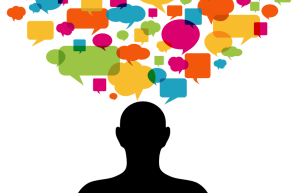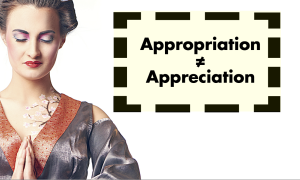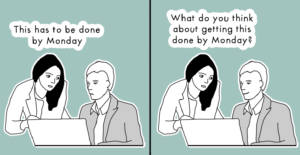
Source: Leading Men
So, you aren’t entirely certain (or maybe you’re very certain) that the gender you were obliged to inhabit for your entire life is not, in fact, who you are.
You might feel elated, relieved, terrified, confused – this is a huge moment in your life. Take some deep breaths. Although this can be an overwhelming process, being yourself can feel amazing.
If you’re questioning – or if you know someone who is looking for resources – I hope this article will be helpful in expediting the process of finding resources and affirming yourself and others.
Much of the advice here is the collective wisdom of my friends and community. And I want to note this is written from the perspective of one white, middle-class, AFAB, genderqueer person.
I think that it can still have value for other members of the trans community, but I want to recognize that there will be limitations on what I can offer.
Also, I’m using “trans” here very broadly. I know that there are people who do not identify as cis who don’t use the word “trans” for themselves. Here, I’m using it to mean anyone whose assigned gender at birth does not fully fit their a/gender identity.
Without further ado, here are some things that I wish I knew when I first started seriously exploring my genders:
1. Only You Define Your Gender or Lack of Gender
If we’re allowed to define relatively trivial parts of our lives – like the foods or hobbies we enjoy – then we certainly get to define something as intense and pervasive as our a/gender identity!
Many people have spent your entire life telling you that you had to be your assigned gender at birth. You don’t have to heed them, though – who you truly are may already be proving them wrong.
Only you can say who you are, how you express yourself, and what that means for your identity. Whatever you define for yourself is right – because you’re the expert on your a/gender identity!
2. Confusion Is Okay
Being the expert on yourself can feel overwhelming. While many trans people have a clear sense of what their a/gender identity is and what it means to them, many others simply do not.
When I was younger, “gender confused” was one of the insults that hit me worst in the gut. It was so invalidating!
There are two implications in this “insult.”
One is that confusion tarnishes the reputation of trans people who are sure about their identities. The other is consternation: How could anyone be unsure of something as important as their a/gender identity?
But confusion is normal, common, and deserves respect.
You may gain more certainty or you may not. But you definitely don’t have to have any or all of the answers – now or later!
3. Go Ahead and Try Things Out
So, where do you start, then?
It’s a good idea to try out a variety of things to see what makes you feel comfortable. Whatever feels right, keep it up!
After years of conforming to others’ expectations, it can be hard to access your sense of self around your a/gender identity. For me, it took at least six months before I even could start to truly recognize myself. Now, I am more settled in myself – and in my gender fluidity.
It can feel imperative to know everything about yourself right away. Dysphoria, which is the distress or discomfort that occurs when the gender someone is assigned does not align with their actual gender, (if you have it) and the stigma around uncertainty can cause a lot of anxiety.
But even though it may feel urgent, you have all the time that you need to make whatever decisions are best for you.
It’s useful to look at others’ processes. At the same time, they are following their own path, and what works for them may not end up being right for you.
Only you know what pace is good for you. You may already have everything figured out, or you may need a lot of time. It’s all okay.
Something might make you happy and comfortable for a little or a long while, and then it might change. You have the right to make changes as little or as often as makes sense for you.
It can feel like you will never be happy until you’ve figured everything out. But you can feel comfortable and happy long before all your ducks are in a row! And if you never figure out any or all of the aspects of your a/gender identity, that’s also 100% okay.
4. So, About Transitioning: What Does It Look Like and What Does It Mean?
In the dominant narrative, transitioning means “full” medical transition. But this narrative was produced by the medical establishment in order to study and control trans people, and it serves no one except those “medical professionals.” (Thankfully, some providers are starting to move from a gatekeeper model to informed consent.)
In reality, transition can look like many things.
Medical transition can mean any medical changes you make that are somehow related to your a/gender identity or sex, including hormones and surgeries – of many varieties and levels.
The current state of your body does not determine your a/gender identity, but it may be important for a variety of reasons to make changes to it – or not.
Whether or not you experience physical dysphoria, you may or may not decide to – or be able to access – medical transition.
Only you can figure out what that looks like for you and what makes sense for you. And only you have the right to determine what to do with your body.
You can also make non-medical body modifications, such as packing, using stand-to-pee devices, tucking, nonsurgical breast enhancement, binding, and facial and body hair removal. This is often a part of social transition.
Social transition is another form of transitioning that can involve changing your name, pronouns, and/or gender expression, or sharing your a/gender identity with others. You have the right to change these things as often as you want or need.
Whether or not you experience social dysphoria, you may decide to do some, any, none, or all of these things. Whatever you do to transition is completely valid.
Sometimes people discuss an internal transition, too – how your own sense of self changes as you accept your a/gender identity. Dysphoria of all kinds can change as you transition, or just depending on the day. You also may never experience dysphoria at all.
All of these things are transitioning. Using the word “trans” or other words like it is a part of transitioning. You don’t need to “come out” for that to be a valid part of who you are.
You can do any, all, or none of these things – and more – in any combination. You can try one thing and then try on something different. You can be very certain what you need or you can have no idea. It’s all valid and okay.
As writer and activist Jess Ide says, “Transitioning is moving even if that movement is a few small steps towards nowhere in particular. …It’s called transitioning because it happens over time rather than all at once.
How you are and feel three months in will not be how you are and feel a year in. Be patient with yourself. You’re figuring it out. …Just take baby steps.”
5. What, Really, Is ‘Trans Enough’ Anyway?
There is, unfortunately, a policing of the borders of “trans” that leaves many of us out. But you are trans if you say you are.
There’s the idea that there are only certain kinds of transitioning that make someone “really” trans. But no matter what your transition looks like, you’re still trans enough.
How can anyone – yourself included – know for sure if you’re trans? Natalie Reed says, “[I]nternalized cisnormativity leads us to assume that we need to prove that we’re trans to ourselves, but that being cis is simply taken as a given.
Being cis isn’t held to anything even close to a comparable standard of ‘evidence,’ and this skews us towards endlessly pursuing a ‘proof’ that can’t ever be found.”
In other words, a frantic search for “proof” of your transness may come up short.
The whole point of all of this isn’t to fit others’ standards, but to make yourself more comfortable (as you are able and safe to do). So I’ll say it again: only you get to define who you are. There is no such thing as a “right” or “enough” way to be trans.
6. Dealing with Negative Feelings and Stigma is Hard
This is not true for everyone, but for many trans people, suicidal feelings are a reality. If you’re experiencing this for any reason, please know that you are not alone.
There is a community out there who cares about you and will support you. And please, please call the Trans Lifeline if you are in crisis (US: 877.565.8860; Canada: 877.330.6366).
I know that many people, myself included, can experience difficulty sometimes accepting and loving themselves as trans.
In addition to internalized transphobia, we confront intense discrimination from all sides. I’m listing some resources in the sections below to connect you with support and community.
Everyone has different feelings about being trans. Not everyone experiences such negativity, and being trans can be glittery and wonderful.
As writer and analyst Elliot Oberholtzer says, “It’s okay to enjoy being trans. It’s okay to romanticize it. It’s okay to mythologize it. It’s okay to laugh at people who don’t get you. It’s okay to be very emotional about it, or very casual.”
Your feelings aren’t right or wrong. They may be pleasant, unpleasant, or a combination, but mostly they just are. And feelings can fluctuate, even over the course of a day. Community and written resources can help you cope.
When I’m struggling, I find this to be one of the most helpful things for me to read.
7. Find (Virtual/Written/Video/Online) Support
The Internet trans community is wide-ranging. It can be hard to know where to start and where to find experiences that resonate with yours. Many well-known resources focus on binary trans people. Most mainstream resources ignore intersecting oppressions and are produced by White trans people.
The resources I suggest here are skewed by my own experience, but I’ve done my best to expand them for others as well. I also want to say that this is just the beginning! There are so many more lovely writers and activists out there than I had space to list.
If you are looking for more information on the Black trans male experience, check out Dr. Kortney Ziegler.
If you are looking for writing of Black trans women, some great voices to check out are Laverne Cox, Janet Mock, Lourdes Ashley Hunter, and Monica Roberts.
There are many non-binary (using the term loosely) people of color to check out, including Janani Balasubramanian and Alok Vaid Menon of darkmatter, b. binaohan, Ngọc Loan Trần, Jamal Lewis, and many others (this link also includes gender-non-conforming people more broadly).
To read about being trans with physical disabilities: Kay Ulanday Barrett and Ngọc Loan Trần. Trans and mentally ill: Sam Dylan Finch, Transgender Mental Health, Captain Glittertoes.
Trans and eating disorders: Trans Folx Fighting Eating Disorders (T-FEED).
Trans and fat: Fat Genderqueers!, the It Gets Fatter Project, and NOLOSE.
If you want to read about being neutrois (which has similarities to, but is still different from, being agender), please check out Neutrois Nonsense.
As a white, AFAB, non-binary person, the blog I most enjoyed when I was first questioning my gender was rainbowgenderpunk. Other non-binary-specific resources include Genderqueerid, Ask a Non-Binary, and Genderqueeries.
Tumblr is a great place to look for trans stories and blogs of all stripes and to enter those conversations.
There is also a huge vlogging community on YouTube. Many vlogs are binary-focused, but a number of vlogs are not. It can be a great way to stay visually/face-to-face connected with others’ stories.
There are so many wonderful books, and some that helped me are Whipping Girl, decolonizing trans/gender 101, and Trans Bodies, Trans Selves. The Gender Book is a good resource for introducing gender to others, and for exploring your own ideas about gender.
I also love reading young adult novels, and there are a small number of them that have trans or non-binary themes.
There are also a bunch of awesome comics to read! Try Assigned Male, Rooster Tails Comic, Manic Pixie Nightmare Girls, robot-hugs, GQutie, Chaos Life, Hourou Musuko, Khaos Komix, and What’s Normal Anyway?, to name a few.
Finally, one of the best ways to join the online trans community is to start blogging or vlogging yourself! An Internet full of people can welcome you.
Your blog/vlog could be a transition catalog, an online journal, a political treatise – or something else entirely!
8. Find (Real-Life) Support
The online and written support I’ve found was and is a huge part of my being able to accept myself and cope in a transphobic world.
It is so helpful to find supportive community in real life. In the beginning stages of questioning, it can be rare to find people who completely affirm your a/gender identity. This can be especially hard when you’re new to this and need affirmation more than ever.
Some people do improve once they start knowing more about trans issues. It would be great if they were affirming at the beginning – you deserve it! – but sometimes it does take time. And sometimes they don’t come around.
In the end, your true friends will unequivocally validate who you are. They won’t make a fuss about pronouns. They will witness the triumphs and struggles you experience, no matter what.
Many people I talk to about their early transition process say that getting to know other trans people was a huge part of their ability to recognize and accept themselves.
Finding in-person trans community can be difficult, and it can be harder when facing intersecting oppressions.
But you can start by looking for trans organizations in your area and going to conferences in your region, if you can afford it and are able. If you can’t find people at the start, keep looking. We’re out there!
Isolation is a real factor in being trans, but there are people who will love and accept you as yourself. If you’re having trouble finding real-life ones, do what you can with the Internet and searching for what you need!
***
In a world designed for cis people, it can be hard to start navigating it as a trans person or someone who is questioning their a/gender identity. Hopefully these tools are a good starting point for your questioning journey.
As you search, you will find many of your own resources. This process can turn your world upside down – and being yourself is so rewarding. Good luck as you begin moving into yourself!
[do_widget id=”text-101″]
Adrian Ballou is a Contributing Writer for Everyday Feminism. A genderqueer writer, artist, activist, and educator who does youth development work both inside and outside the classroom, they particularly enjoy writing and facilitating social justice education and youth organizing curriculum. To learn more about their consulting and speaking work, check them out here. In their free time, they cook lots of food, sing songs, make art, and practice their Spanish, Hindi, and Urdu. Read their articles here.
Search our 3000+ articles!
Read our articles about:
Our online racial justice training
Used by hundreds of universities, non-profits, and businesses.
Click to learn more




















